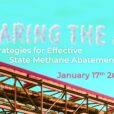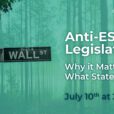In January of 2021, President Biden made a commitment to ensuring that 40 percent of certain federal investments related to climate and the environment benefit disadvantaged communities, the Justice40 Initiative. While this lofty goal designates climate justice as a national priority, implementing and delivering on this promise is not so simple.
To explore how best to tackle implementing the Justice40 (J40) Initiative, L4GG and Climate XChange brought together a panel of experts, including Kristin Wood, J40 Lead at the Department of Transportation; Kirsten Baumgart Turner, Deputy Energy Officer for the Hawai’i State Energy Office; and Zach Lou, Coalition Manager of the California Green New Deal Coalition. Joined by L4GG and CXC experts, we discussed collaboration between the different levels of government, different state approaches to J40, and the importance of community engagement in the context of implementing the federal J40 goal.
In this recap article, we’ll provide a review of L4GG and CXC’s J40 overview, as well as highlights from our expert panel’s presentations and Q&A, and key takeaways for communities, NGOs, industry, and of course, federal, state, and local governments.
Justice40 Initiative Overview, L4GG & CXC
The Justice40 (J40) Initiative establishes a goal that 40 percent of federal climate, energy, and water investments flow to disadvantaged communities (DACs), which are identified as “communities that are marginalized, underserved, and overburdened by pollution”. This goal applies to roughly $2.2 trillion of incoming federal funding, including through the American Rescue Plan (ARPA), the Infrastructure Investment and Jobs Act (IIJA), and the Inflation Reduction Act (IRA) — $1.2 trillion of which must be spent in the next five years. Eligible grantees include state and local governments, non-governmental organizations (NGOs), industry, and more, which means that all of these stakeholders must understand and comply with J40 upon utilizing these funds.
Implementing J40, then, obviously requires coordination across all levels of government and all types of stakeholders. Executive Order 14008, which established J40, also created several new federal entities within the White House to lead and coordinate implementation, including the Office of Domestic Climate Policy, the Environmental Justice (EJ) Interagency Council, and the EJ Advisory Council. These new entities were joined by the existing White House Council on Environmental Quality (CEQ), which was tasked with preparing an interactive map of DACs across the country, and the Office of Management and Budget (OMB) to develop a whole-of-government approach to implementing J40.
Federal J40 Guidance
After establishing the goal through executive order, the White House issued interim guidance to federal agencies on how to implement J40. This memo, released by OMB in July of 2021, provides several pieces of guidance:
- An interim general definition for a ‘disadvantaged community’, using various criteria including designations of low-income, high unemployment, racial and ethnic segregation, linguistic isolation, high housing cost burden, and more.
- Direction to federal agencies to identify their own definition of a DAC based on their specific areas of regulation.
- Direction to federal agencies to develop a stakeholder engagement plan, identify how to maximize benefits in DACs and significant barriers to doing so, consider program modifications if necessary, and develop methods to track and measure benefits and burdens.
Federal agencies are still issuing guidance on DAC definitions, updated mapping tools, and general program guidance for J40 implementation.
In February of 2022, CEQ issued their draft federal map of DACs through the Climate and Economic Justice Screening Tool, with the caveat that further localized data is necessary for state actors to identify DACs. Later in 2022, in time for the passage of the IRA, OMB released an updated list of the 300+ covered federal programs.
J40 Covered Programs and Agencies
Programs that fall within the scope of J40 must include investments in one of the following areas: climate change, clean energy and energy efficiency, clean transportation, affordable and sustainable housing, training and workforce development, remediation and reduction of legacy pollution, and critical clean water and waste infrastructure. Existing programs that fall within this scope are administered by at least 17 different federal agencies, although the Environmental Protection Agency (EPA), Department of Transportation (DOT), and Department of Energy (DOE) are major players.
As required by the executive order that established J40, CEQ is developing an Environmental Justice Scorecard to track and measure J40 implementation. Through this tool, they aim to identify activities by federal agencies that reduce disproportionate harms and burdens, deliver investment benefits, and center justice in decision-making.
Community Engagement in J40
Successfully implementing J40 requires engaging communities not only in identifying DACs but also in designing and executing covered projects and programs. This means all stakeholders must actively pursue community engagement to ensure that communities’ needs are prioritized, with various end goals:
- Equitable decision-making. All community members, especially those who have been historically excluded, must have a meaningful opportunity to provide input. This actively shifts power to those on the margins and structures public participation processes to be accessible for all members of the community.
- Meaningful relationship-building. The entities organizing decision-making processes must ensure that they effectively create long-lasting trust and respect in their relationships with community members.
- Sustainable capacity-building. Instead of relying on external assistance, communities should be provided with the resources they need to implement solutions.
- Continuous transparency and accountability. Organizing entities must be clear about their intentions, truthful about their progress, and they must follow up on promises they’ve made. This requires accessible communication with all community stakeholders and firm, official structures to hold everyone involved accountable.
With this background knowledge on the Justice40 Initiative and its necessary components, we invited three experts to explore J40 implementation at the federal, state, and community levels, including options for the legislative and executive branches.
Kristin Wood, Department of Transportation
Kristin Wood is the Director of Planning and Program Development at the Federal Transit Administration (FTA) and leads J40 implementation within the U.S. Department of Transportation (DOT). DOT is working in concert with the White House and other federal agencies to implement J40 across all covered programs.
DOT is incorporating J40 across their covered programs through a department-wide approach. They are asking grant applicants to address the benefits and burdens of projects for disadvantaged populations and prioritizing projects that promote consistent, meaningful public engagement. Further, they are evaluating programs and regulations with an equity lens and prioritizing resources to historically underserved communities. To ensure communities receive the support they need, they are also providing additional technical assistance and support for DACs.
DOT has various resources available to help navigate the influx of federal funding, including the DOT Navigator, an online portal to access DOT’s technical assistance resources. They also have various technical assistance programs, such as the ROUTES program to address rural transportation’s unique challenges, and the Thriving Communities program to provide technical assistance and capacity building resources for transportation improvements.
Kirsten Baumgart Turner, Hawai’i State Energy Office
Kirsten Baumgart Turner is the Deputy Energy Officer for the Hawai’i State Energy Office (HSEO), where they are prioritizing community engagement on their path to energy justice — an avenue that other state agencies can explore to implement the goals of J40 without legislative action.
Their first step to prioritizing community engagement was creating a Civic Advisory Group composed of residents who felt they had little input in decision-making processes and distribution of benefits in the energy projects in their communities. Through this and other dialogues with community members, they realized various necessary steps they needed to take to actualize energy justice in their communities, including building awareness about renewable energy projects and incorporating residents’ feedback into decision making. In previous years, they had focused on engaging industry stakeholders but had left out the communities where these projects were sited. Redefining ‘stakeholders’ to include every energy user in the state was a priority, but they didn’t have the bandwidth, expertise, or funding to make that progress.
In order to increase HSEO’s capacity to tackle increasing community engagement, they worked with the Hawai’i Climate Change Commission to develop the first state government AmeriCorps VISTA Program. Through this program, they hired three full-time staff to focus on energy and transportation affordability, as well as community outreach and engagement. These staffers researched energy equity issues in Hawai’i and surveyed industry and HSEO staff to identify gaps in their energy equity strategy. Using this analysis, HSEO released an RFP to contract culturally-focused community engagement experts and developed a suite of entirely new initiatives to bridge the gap between HSEO and communities.
The AmeriCorps VISTA team pulled together a group of energy equity-minded professionals across the public and private sectors, informally launched in January of 2021 as the Energy Equity Hui. This group meets monthly to share best practices on incorporating equity into energy work, and they have dedicated work streams for developing an energy equity definition and framework, identifying pro-energy equity state legislation, and working with utilities to make utility-scale energy projects more equitable.
Utilizing the work of the AmeriCorps VISTA team and the Energy Equity Hui, HSEO created a novel, state-wide program to recruit and train community members to bridge the gap between HSEO and their communities. This is the Clean Energy Wayfinders program, which involves communities in co-creating strategies to increase access to resources in clean transportation, energy efficiency, renewable energy, and workforce development.
To support their growing energy equity work, HSEO has leveraged federal funds to hire a full-time Community Outreach and Engagement Specialist. They’ve also worked with consultants to develop a new stakeholder engagement strategy, Energize Kākou, that is grounded in a Native Hawaiian cultural framework and is the result of statewide community workshops. This strategy prioritizes community representation in future renewable energy projects, ongoing policy and project development, and participation in workforce training and other support services.
Each of these initiatives builds focused capacity on implementing energy equity and, therefore, implementing the goals of J40, throughout HSEO.
Zach Lou, California Green New Deal Coalition
Zach Lou is the Coalition Manager for the California Green New Deal Coalition, which co-sponsored AB 2419, the California Justice40 Act, in 2022 — an example of how community-led coalitions and state actors can tackle implementing Justice40 through legislative action.
AB 2419 (introduced by Assemblymember Bryan) sought to codify the federal J40 goal into California law by requiring at least 40 percent of federal climate and infrastructure funds benefit DACs, and an additional 10 percent benefit low-income communities. It also aimed to create good jobs through high-road labor standards on large-scale construction projects, as well as ensuring community voices are heard through the creation of an advisory committee to provide recommendations on how to use funds to improve climate, equity, and labor outcomes across the state. The bill was supported by various groups across climate, environmental justice, labor, and more.
The bill was introduced in California’s 2021-2022 legislative session but died in the Senate, though it may be reintroduced in the coming session. The coalition faced some challenges in developing and pushing this bill to implement J40, especially related to the ever-changing and incomplete landscape of federal and state guidelines. While J40-eligible ARPA and IIJA funding is already flowing to states, federal guidance on implementing J40 is still being developed. This created challenges in ensuring the policy design smoothly fit state and federal agencies’ needs in administering the funds. Further, while California already has a variety of maps, tools, and other resources to direct funding to DACs, state agencies do not have a comprehensive or consistent approach to prioritizing equity in funding decisions.
AB 2419 is not only a legislative mechanism to codify J40 at the state level, but it is also an organizing and power-building tool for justice-centered coalitions. Implementing justice and equity goes beyond J40 — it requires all stakeholders to develop a comprehensive and holistic approach to prioritizing equity in investments. J40 can and should be used as a starting place for local and state actors to think beyond policy and actually build capacity for DACs to access, apply for, and receive funding for community-driven projects.
Conclusion & Key Takeaways
The Justice40 Initiative, while a lofty and admirable goal, requires significant state-level work to implement successfully. Federal J40 guidelines are still in development, but states can take action now to ensure they prioritize equity in their portion of the covered federal investments, and in all funding decisions. State governments will play a huge role in identifying DACs and prioritizing projects that benefit them; this must be rooted in robust, continuous community engagement processes with dedicated staff resources. NGOs will also play a big role, both in facilitating communication between communities and governmental actors, and in advocating for legislation like CA’s AB 2419 to codify J40 into state law. Industry actors should also ensure that their public-private partnerships are prioritizing benefits in DACs and equity in decision-making processes, and they can work to shift power away from private interests like themselves and toward community voices.
State-level action may look like building out capacity in state agencies, like in Hawaii’s State Energy Office, or it may be legislative action, like in CA’s AB 2419. Alternatively, there may be no official government action that explicitly addresses J40 — still, stakeholders can work to deeply engage communities in program and policy design, implementation, and evaluation to ensure the needs of communities are prioritized.








